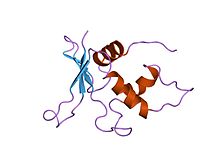Interferon regulatory factors
| Interferon regulatory factor transcription factor | |||||||||
|---|---|---|---|---|---|---|---|---|---|
 interferon regulatory factor-2 dna binding domain, nmr, minimized average structure | |||||||||
| Identifiers | |||||||||
| Symbol | IRF | ||||||||
| Pfam | PF00605 | ||||||||
| InterPro | IPR001346 | ||||||||
| SCOP2 | 1if1/SCOPe/SUPFAM | ||||||||
| |||||||||
Interferon regulatory factors(IRF) are proteins which regulatetranscriptionofinterferons(seeregulation of gene expression).[1]Interferon regulatory factors contain aconservedN-terminalregion of about 120amino acids,whichfoldsinto astructurethat binds specifically to the IRF-element (IRF-E) motifs, which is locatedupstreamof the interferongenes.[2]Some viruses have evolved defense mechanisms that regulate and interfere with IRF functions to escape the host immune system.[3]For instance, the remaining parts of the interferon regulatory factor sequence vary depending on the precise function of the protein.[2]TheKaposi sarcomaherpesvirus,KSHV,[4]is a cancer virus that encodes four different IRF-like genes;[5]including vIRF1,[6]which is a transforming oncoprotein that inhibits type 1 interferon activity.[7]In addition, the expression of IRF genes is under epigenetic regulation by promoter DNAmethylation.[8]
Role in IFN signaling[edit]
IRFs primarily regulatetype I IFNsin the host after pathogen invasion and are considered the crucial mediators of an antiviral response. Following a viral infection, pathogens are detected byPattern Recognition Receptors(PRRs), including various types ofToll-like Receptors(TLR) and cytosolic PRRs, in the host cell.[3]The downstream signaling pathways from PRR activationphosphorylateubiquitously expressed IRFs (IRF1,IRF3,andIRF7) through IRFkinases,such asTANK-binding kinase 1(TBK1).[9]Phosphorylated IRFs are translocated to the nucleus where they bind to IRF-E motifs and activate the transcription of Type I IFNs. In addition to IFNs, IRF1 andIRF5has been found to induce transcription ofpro-inflammatory cytokines.
Some IFNs likeIRF2andIRF4regulate the activation of IFNs and pro-inflammatory cytokines through inhibition. IRF2 contains arepressorregion that downregulates expression of type I IFNs. IRF4 competes with IRF5, and inhibits its sustained activity.[3]
Role in immune cell development[edit]
In addition to the signal transduction functions of IRFs ininnate immune responses,multiple IRFs (IRF1, IRF2, IRF4, andIRF8) play essential roles in the development of immune cells, includingdendritic,myeloid,natural killer(NK),B,andTcells.[3]
Dendritic cells (DC) are a group of heterogeneous cells that can be divided into different subsets with distinct functions and developmental programs. IRF4 and IRF8 specify and direct thedifferentiationof different subsets of DCs by stimulating subset-specific gene expression.[3]For example, IRF4 is required for the generation ofCD4+ DCs, whereas IRF8 is essential forCD8α+ DCs. In addition to IRF4 and IRF8, IRF1 and IRF2 are also involved in DC subset development.
IRF8 has also been implicated in the promotion ofmacrophagedevelopment fromcommon myeloid progenitors(CMPs) and the inhibition of granulocytic differentiation during the divergence ofgranulocytesandmonocytes.
IRF8 and IRF4 are also involved in the regulation of B and T-cell development at multiple stages. IRF8 and IRF4 function redundantly to drivecommon lymphoid progenitors(CLPs) to B-cell lineage. IRF8 and IRF4 are also required in the regulation ofgerminal center(GC) B cell differentiation.
Role in diseases[edit]
IRFs are critical regulators of immune responses and immune cell development, and abnormalities in IRF expression and function have been linked to numerous diseases. Due to their critical role in IFN type I activation, IRFs are implicated inautoimmune diseasesthat are linked to activation of IFN type I system, such assystemic lupus erythematosus(SLE).[10]Accumulating evidence also indicates that IRFs play a major role in the regulation of cellular responses linked tooncogenesis.[11]In addition to autoimmune diseases and cancers, IRFs are also found to be involved in the pathogenesis of metabolic, cardiovascular, and neurological diseases, such ashepatic steatosis,diabetes,cardiac hypertrophy,atherosclerosis,andstroke.[3]
Genes[edit]
See also[edit]
References[edit]
- ^Paun A, Pitha PM (2007)."The IRF family, revisited".Biochimie.89(6–7): 744–53.doi:10.1016/j.biochi.2007.01.014.PMC2139905.PMID17399883.
- ^abWeisz A, Marx P, Sharf R, Appella E, Driggers PH, Ozato K, Levi BZ (December 1992)."Human interferon consensus sequence binding protein is a negative regulator of enhancer elements common to interferon-inducible genes".The Journal of Biological Chemistry.267(35): 25589–96.doi:10.1016/S0021-9258(19)74081-2.PMID1460054.
- ^abcdefZhao GN, Jiang DS, Li H (February 2015)."Interferon regulatory factors: at the crossroads of immunity, metabolism, and disease".Biochimica et Biophysica Acta (BBA) - Molecular Basis of Disease.1852(2): 365–78.doi:10.1016/j.bbadis.2014.04.030.PMID24807060.
- ^Chang Y, Cesarman E, Pessin MS, Lee F, Culpepper J, Knowles DM, Moore PS (December 1994)."Identification of herpesvirus-like DNA sequences in AIDS-associated Kaposi's sarcoma".Science.266(5192): 1865–9.Bibcode:1994Sci...266.1865C.doi:10.1126/science.7997879.PMID7997879.S2CID29977325.
- ^Offermann MK (2007). "Kaposi Sarcoma Herpesvirus-Encoded Interferon Regulator Factors".Kaposi Sarcoma Herpesvirus: New Perspectives.Current Topics in Microbiology and Immunology. Vol. 312. pp. 185–209.doi:10.1007/978-3-540-34344-8_7.ISBN978-3-540-34343-1.PMID17089798.
- ^Moore PS, Boshoff C, Weiss RA, Chang Y (December 1996). "Molecular mimicry of human cytokine and cytokine response pathway genes by KSHV".Science.274(5293): 1739–44.Bibcode:1996Sci...274.1739M.doi:10.1126/science.274.5293.1739.PMID8939871.S2CID29713179.
- ^Gao SJ, Boshoff C, Jayachandra S, Weiss RA, Chang Y, Moore PS (October 1997)."KSHV ORF K9 (vIRF) is an oncogene which inhibits the interferon signaling pathway".Oncogene.15(16): 1979–85.doi:10.1038/sj.onc.1201571.PMID9365244.
- ^Rotondo JC, Borghi A, Selvatici R, Magri E, Bianchini E, Montinari E, et al. (August 2016). "Hypermethylation-Induced Inactivation of the IRF6 Gene as a Possible Early Event in Progression of Vulvar Squamous Cell Carcinoma Associated With Lichen Sclerosus".JAMA Dermatology.152(8): 928–33.doi:10.1001/jamadermatol.2016.1336.PMID27223861.
- ^Shah, Masaud; Choi, Sangdun (2016), "Interferon Regulatory Factor", in Choi, Sangdun (ed.),Encyclopedia of Signaling Molecules,New York, NY: Springer, pp. 1–10,doi:10.1007/978-1-4614-6438-9_101496-1,ISBN978-1-4614-6438-9
- ^Santana-de Anda K, Gómez-Martín D, Díaz-Zamudio M, Alcocer-Varela J (December 2011)."Interferon regulatory factors: beyond the antiviral response and their link to the development of autoimmune pathology".Autoimmunity Reviews.11(2): 98–103.doi:10.1016/j.autrev.2011.08.006.PMID21872684.
- ^Yanai H, Negishi H, Taniguchi T (November 2012)."The IRF family of transcription factors: Inception, impact and implications in oncogenesis".Oncoimmunology.1(8): 1376–1386.doi:10.4161/onci.22475.PMC3518510.PMID23243601.
External links[edit]
 Media related toInterferon regulatory factorsat Wikimedia Commons
Media related toInterferon regulatory factorsat Wikimedia Commons- Interferon+regulatory+factorsat the U.S. National Library of MedicineMedical Subject Headings(MeSH)
